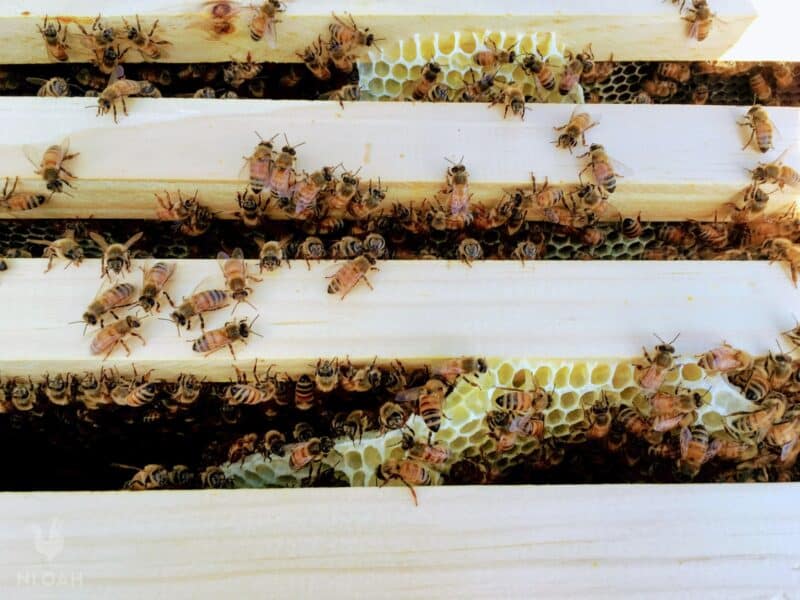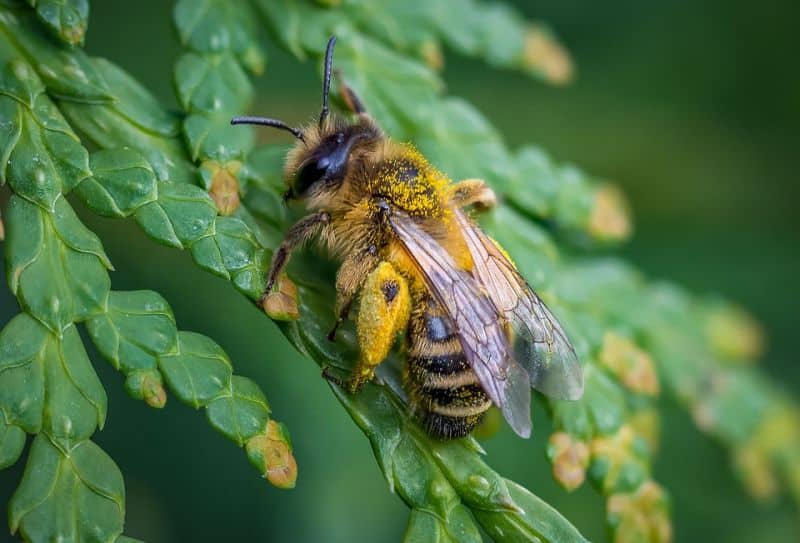You don’t have to look very closely at a bee to see that they are some hairy little creatures. They are covered, quite literally, from head to tail in fine, fuzzy hair.

They even have hair growing on their eyes! Of course, this hair isn’t merely for decoration: this is special hair, and is designed to be sticky to the touch.
The next obvious question: why do bees have sticky hair?
Bees that have sticky hair mostly as a means to help them gather as much pollen as quickly and as efficiently as possible while they drink nectar. A bee’s sticky hair also serves a variety of other important survival purposes.
I have no doubt you’ve heard the old, wonderful joke about bees having sticky hair because they use honey combs (hyuk hyuk) but in this case the joke doesn’t quite live up to the reality of how a bee’s hair actually is.
It is sticky, but not sticky because they are rolling around in honey. Bees are far too fastidious and clean for that.
Anyway, I can promise that the real reason is way more fascinating than a bad joke, so keep reading if you want to learn more.
Sticky Hair Makes Pollen Collection a Snap for Bees
Probably the most obvious and well-known reason why bees have sticky hair is because it helps them collect as much pollen as possible while gobbling up nectar from flowers.
This is what makes bees such excellent pollinators…
Once enough nectar is gathered, it will be used back at the hive and put to work making honey and other resources that the bees need while excess pollen is scraped off.
But, the hair isn’t just sticky to the touch in the traditional sense to fulfill this role. Far from it! If you look at a bee’s hair under a microscope, it has a forked, thorny appearance that looks a little bit like the branches radiating off of a stunted tree.
It is this special design that makes it so easy for these hairs to trap pollen with even the most passing touch.
Then, more pollen will stick to that pollen and before you know it a bee is completely covered in the stuff.
The propensity of this sticky hair to do the job of capturing and carrying pollen is easily seen on a bee’s back legs.
Each of these legs has a specialized patch of hairs optimized for this exact job, known as a pollen basket.
You can usually see a clump of pollen on each of these spots when a bee has been busy gathering in the wild, easily visible with the naked eye.

Sticky Hairs Are Good for More than Just Pollen
Of course, we wouldn’t be doing the marvelous physiology of a bee justice if we didn’t talk about the other critical purposes that their hair serves.
It’s no exaggeration whatsoever to say that a bee’s hair is absolutely integral to its survival and well-being, both as an individual and as a member of the hive. A bee without any hair wouldn’t be a bee for long!
Bees Use Hair to Sense Their Environment
Bees don’t really hear in the same way that we do, and although they have surprisingly sophisticated eyesight thanks to their five eyes, bees rely on their hairs to fill in the gaps concerning the environment around them.
These are incredibly sensitive to vibrations thanks to their many hairs, and the specialized hairs on their legs help them gather information about their immediate environment, the surface they are standing on and even discerning what food is good to eat or not.
That’s right, bees literally taste their food using specialized hairs on their forelegs in conjunction with their tongues.
If that’s not amazing, I don’t know what is…
Bee Hair is Also Thought to Aid in Navigation
If you thought that last fact was incredible, hold on to your hat, or rather your hair: there’s a fair bit of scientific evidence that suggests bees rely on their hair to help them navigate by sensing wind direction and, potentially, the airspeed of the bee itself.
Even more incredible, it is suspected that it is the incredibly fine, tiny hairs that grow on a bee’s compound eyes responsible for this function.
In conjunction with a bee’s ability to keep track of the position of the sun and correlate its travels based on the presence of different wavelengths of light, the information provided by the hair also allows a bee to navigate incredible distances, several miles away from its hive, in order to find food and return home consistently with incredible accuracy.
Their Hair Also Helps Them Stay Warm and Keep Other Bees Warm, Too
A bee’s hair also serves a more mundane purpose, but one that’s still vitally important: it will help to keep the bee warm when it is cold, and also help the bee keep other bees warm.
A bee’s hair does help trap warm air close to its body and keep it alive when it gets cold out, but bees are famous for working together.
During the winter time, bees clump up in huge piles around the queen and gently vibrate in order to warm and trap a volume of air that will keep some of the bees alive until the weather warms up- and most importantly the queen herself!
Consider this way, a bee’s hair is not much different from our own or any other animal’s.
Do Bees Have Hair or Fur, Technically?
This is a question for the ages, and one that rages concerning many creatures in the animal kingdom. You’ll have to make up your own mind, but most experts refer to a bee’s hair as exactly that: hair.
But when you compare hair to fur, you’ll see that hair typically grows to an indeterminate length, and requires constant trimming so that it does not get too long.
Fur, on the other hand, reaches a predetermined length and then stops growing for an interval, usually a season, but perhaps the lifetime of the animal.
On the other hand, or perhaps strand, hair doesn’t really provide enough insulation value in the same way that proper fur does, because fur is usually somewhat water resistant and thicker.
Then there is the fact that fur typically is used to refer to animals, whereas hair is almost, but not entirely, used exclusively in the context of humans.
Ultimately, hair and fur are made from the same materials and serve many of the same purposes. For my part, I think the term “bee fur” just sounds too strange and prefer “bee hair” instead.
Tom has lived and worked on farms and homesteads from the Carolinas to Kentucky and beyond. He is passionate about helping people prepare for tough times by embracing lifestyles of self-sufficiency.
